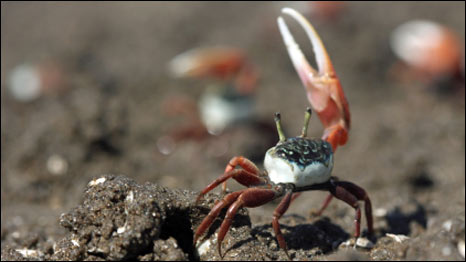Robocrab 机械螃蟹
Robocrab 机械螃蟹
By Jennifer Carpenter, BBC News

Male fiddler crabs have to use their best dancing moves to attract a mate
媒体英语会带大家一起学习 BBC 撰稿人在报道世界大事时常用到的单词和短语。
Background: 招潮蟹在英语里被称为 fiddle crab. 这是因为它们拥有一只特别大的螯,就像小提琴一样。现在科学家们采用了一个机械螃蟹来说明雌蟹喜欢那些能够以最大舞蹈动作来显佩自己的雄蟹。
收听与下载
To the fiddler crabs, the Australian mudflats in the north of the country are a heaving dance floor, where a male must rely on his moves to attract a mate.
Male crabs attract passing females by waving their large yellow claws. If a female fancies a male, she will disappear down his burrow in the sand, and if she likes the hole as much as she likes the wave, she'll stay and mate.
But how do females choose between all of these waving suitors? Now a team from the Australian National University in Canberra have worked out what female crabs are looking for in a mate.
Sat beneath the unforgiving Australian sun, the researchers set up three fully adjustable robotic arms, that they are calling the Robocrab. Robocrab allows the researchers to vary the speed of the waves and the size of the claws.
The team showed that females prefer males with larger claws, and more vigorous waves, especially if the male is flankedby two less athletic wavers.
It seems, for the fiddler crabs at least, it pays to beef up, but hang outwithweedy friends.
Glossary 词汇表 (收听发音, 请单击英语单词)
- a suitor追求者
- unforgiving持续炎热的,不能原谅的
- vigorous生龙活虎,精力旺盛的
- to be flanked by something 一边一个
- to beef up强壮
- to hang out with与他人一起消磨时间
- weedy 软弱的